The next day was our day for exploring the Huon Valley. Our plan was to drive to Cockle Creek – the furthest south it is possible to drive – and make our way back, stopping at places of interest.  We had booked seats on the Ida Bay Historical Railway, the most southern railway in Australia.
We had booked seats on the Ida Bay Historical Railway, the most southern railway in Australia.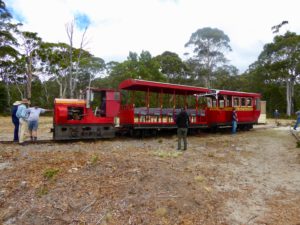 Located at Lune River, 113 kilometers and roughly two hours drive south of Hobart; the Ida Bay Railway enables you to enjoy the area’s secluded wilderness. The 610 mm (2 foot) gauge tramway traverses 6.8 kilometers of Tasmanian bush and beach, estuaries and button grass plains. It is a two hour return trip on a restored section of this historic line, riding in passenger carriages built on 1890s bogie flat wagons, which are hauled by 1940s Malcolm Moore locomotives.
Located at Lune River, 113 kilometers and roughly two hours drive south of Hobart; the Ida Bay Railway enables you to enjoy the area’s secluded wilderness. The 610 mm (2 foot) gauge tramway traverses 6.8 kilometers of Tasmanian bush and beach, estuaries and button grass plains. It is a two hour return trip on a restored section of this historic line, riding in passenger carriages built on 1890s bogie flat wagons, which are hauled by 1940s Malcolm Moore locomotives.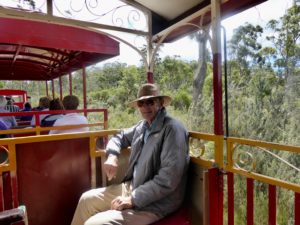
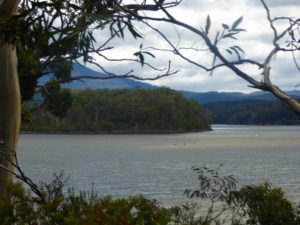 Deephole Bay marks the line’s end where there is a long, white sand swimming beach, accessible only by rail.
Deephole Bay marks the line’s end where there is a long, white sand swimming beach, accessible only by rail. 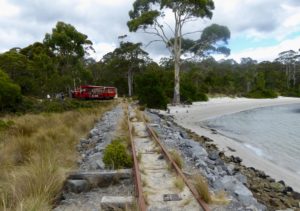
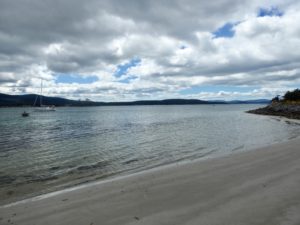
Along the way the guard talked about the history of this wild and remote place. Convicts escaping from Hobart would head down there and stake their (illegal) claim to a bit of land. It was a totally lawless wilderness. The first settlers to arrive where tough people who endured incredible hardship. The Jager family settled at Jager’s Bay and established a timber mill, built boats, developed the southern most orchard in the Huon, built an interesting homestead (the foundations and remains of gardens still exist). They later moved further up to the Lune River area and went into partnership with the Tyler family.
Edmund Tyler was a convict and later a trusted guard. He set up a brick kiln at a former convict station at Hythe (now Southport), and later a brick company at Brick Point, Ida Bay.
He set up a timber mill at Ida Bay and joined forces with the Jagers when his daughter married one of the Jager sons.
As well as the timber mill W H Tyler & A J Jager & Sons were involved in commercial fishing for many years. They built and owned several famous boats including the ‘Parappa’ (the aboriginal word for dolphin), a vintage 50’ Huon Pine fishing vessel built in 1915 that has now been fully restored and is for sale in Hobart for $65,000. In 1897, they lost everything in a bush fire and though they built a new mill they never really recovered. The Tylers discovered the Ida Bay caves and a marble cliff and a company was established to quarry the marble. The first party of tourists to explore the caves was in the year 1893.
The Tyler/Jager graveyard is one of the stops on the rail journey. 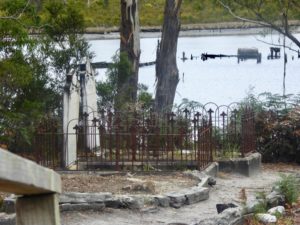 There most of the adults and older children are buried. Christina Jager (nee Tyler) had 24 children and was an Amazonian figure on the Lune. Many of the children did not survive.
There most of the adults and older children are buried. Christina Jager (nee Tyler) had 24 children and was an Amazonian figure on the Lune. Many of the children did not survive. 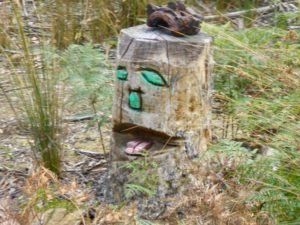
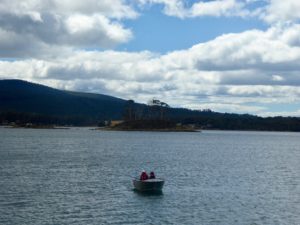 It may be possible to drive to Cockle Creek but we took one look at the rutted gravel and sand track and decided that the drive would not be appreciated by us or Europa Car Hire. Instead we made our way back to Geeveston where, to our surprise, most of the shops were closed. We had some lunch, looked at the wonderful carved figures of local celebrities
It may be possible to drive to Cockle Creek but we took one look at the rutted gravel and sand track and decided that the drive would not be appreciated by us or Europa Car Hire. Instead we made our way back to Geeveston where, to our surprise, most of the shops were closed. We had some lunch, looked at the wonderful carved figures of local celebrities 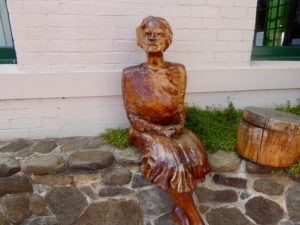
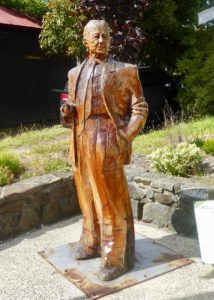
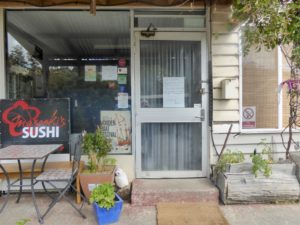 The sushi chef and his restaurant Masaaki’s is so well renowned in Tasmania that he only needs to work three days a week.
The sushi chef and his restaurant Masaaki’s is so well renowned in Tasmania that he only needs to work three days a week.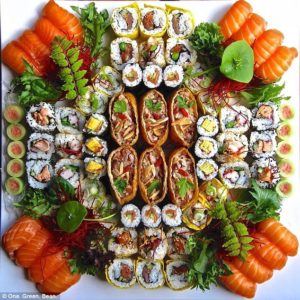 A notice on the door said he would be away for several weeks and was closed.
A notice on the door said he would be away for several weeks and was closed.
Fortunately the Wooden Boat Centre at Franklin was not closed and we spent an interesting hour there looking over the workshop. There were a number of student there who were building boats. They take a nine-week course and advance from never handling tools to building a beautifully crafted wooden dinghy. It was very interesting the process of boat building and seeing the boats in the different stages of development. 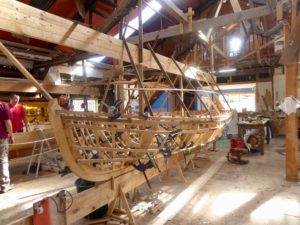
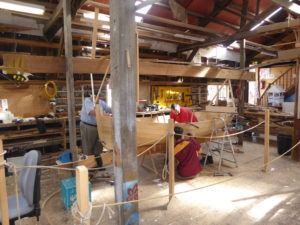
 There was a lovely dinghy being built by an 80-year-old master boat builder for his grandson. As well as building boats they also restore boats and had a number of boats in being stripped down and restored.
There was a lovely dinghy being built by an 80-year-old master boat builder for his grandson. As well as building boats they also restore boats and had a number of boats in being stripped down and restored.
We mentioned that we had come down for the Wooden Boat Show with some friends whose son had built his own boat and had brought it down. Our guide asked the name of the boat and when we said ‘Boxer’ looked highly amused. Struggling to find the right words (I think notorious was the word he was avoiding) he said that the Boxer boys were well known in boating circles and they looked forward to them coming down when the Boat Show was on.
By then it was 5pm and the Boat Centre was closing so we went down to the marina and had a look at the wooden boats anchored there – well worth seeing as it included some restored boats.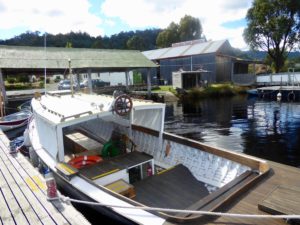

We still had time to finally make it to Willie Smiths Apple Shed and taste test some of the ciders there before heading back to the comfort of Helmsman’s House, a fire and a long soak in the deep bath.
Next day was our long lunch at Fat Pig Farm – a day we had been looking forward to and which certainly lived up to our expectations. 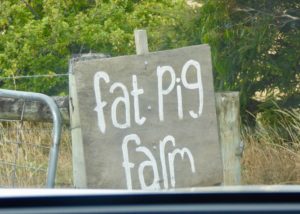 The tone of the day was set when we arrived to find Sadie in fits of laughter because she had managed to cause a traffic jam in their carpark. She and Matthew proved to be amusing and likeable hosts, passionate about what they are doing and wanting to ensure that everyone had a good time.
The tone of the day was set when we arrived to find Sadie in fits of laughter because she had managed to cause a traffic jam in their carpark. She and Matthew proved to be amusing and likeable hosts, passionate about what they are doing and wanting to ensure that everyone had a good time.
We joined the other guests on the verandah having been served a Rhubarb Cordial with McHenry’s Gin and offered little Goat Pies with Yoghurt Cream Pastry to nibble on. Chatting with the other guests we found they were a very diverse lot from all around the country. We sat with a couple from Adelaide and another from south of Perth and yet another from Melbourne. 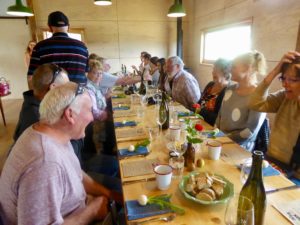 After a welcome from Matthew and Sadie and an explanation of the menu (based on what has been picked from the garden that day plus produce from nearby food artisans), started on our lunch. The appetizer was surprisingly a baby turnip, just picked that morning and tasting quite unlike the turnips you normally buy and with the crunchiness of an apple.
After a welcome from Matthew and Sadie and an explanation of the menu (based on what has been picked from the garden that day plus produce from nearby food artisans), started on our lunch. The appetizer was surprisingly a baby turnip, just picked that morning and tasting quite unlike the turnips you normally buy and with the crunchiness of an apple.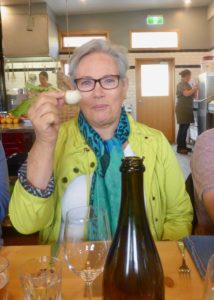
The first course was Roasted Vegetable Soup with shared platters consisting of Tongola’s Zoe, (which is a fresh lactic goats curd and is a finalist in the dairy category of Delicious Magazine’s Australian Produce Awards). 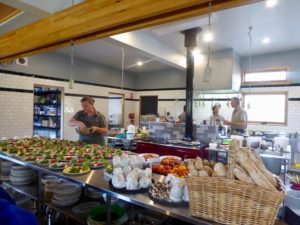
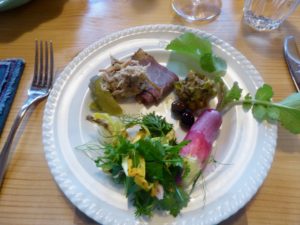 The first course was served with Bruny Island Cloudy Bay IPA, a hop forward beer style made from Tasmanian grains.
The first course was served with Bruny Island Cloudy Bay IPA, a hop forward beer style made from Tasmanian grains.
This was followed by three share platters served with a 2016 Springvale Gewurtztraminer and then a Pork and Tomatilio Stew with Blush Potatoes and a Farmer’s Salad with Summer Flowers served with a 2016 Pooley Pinot Noir.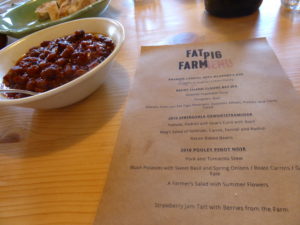
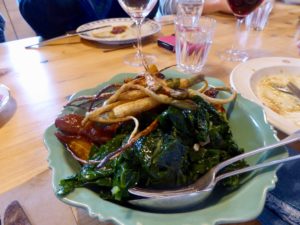
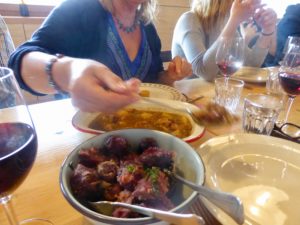
Now fairly replete with food it was time to take a break and a tour of the farm which was conducted by Sadie. 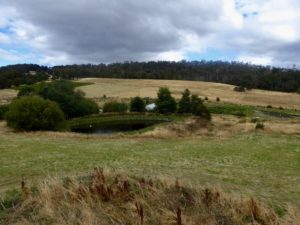 Down the hill to the dam, through the apple orchard -stopping to chat to the pigs
Down the hill to the dam, through the apple orchard -stopping to chat to the pigs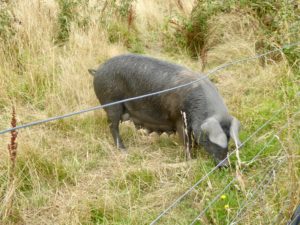 – to the heart of the farm which was the vegetable and produce garden and greenhouses.
– to the heart of the farm which was the vegetable and produce garden and greenhouses. 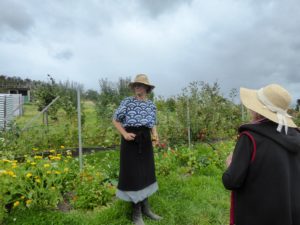
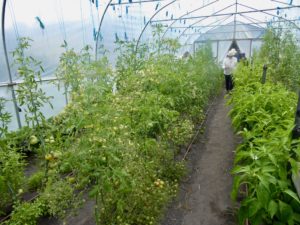
Back to the table for a Strawberry Jam Tart with Berries, coffee or tea and little homemade almond biscuits and then it was time to go, stopping only to get a couple of Matthew’s cook books with their interesting recipes and sensational photos. 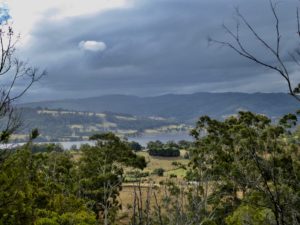
Tomorrow is Bruny Island…….